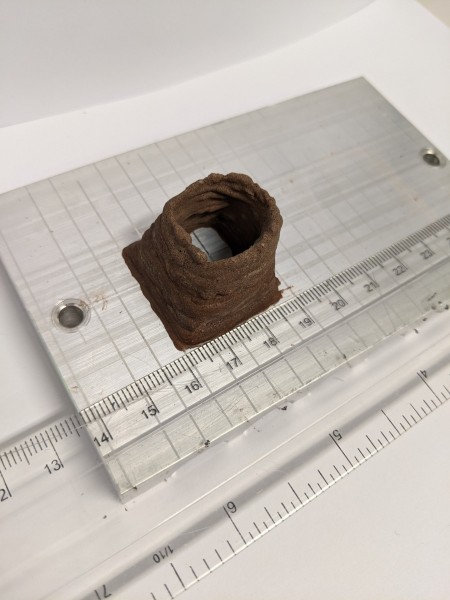Thinking outside the box has always been a strong suit of space exploration. Whether taking a picture of the Earth in a sunbeam or attempting to land a rocket on a floating ship, trying new things has been a continual theme for those interested in learning more about the universe. Now, a team from the University of Manchester has come up with an outside-the-box solution that could help solve the problem of building infrastructure in space – use astronauts themselves as bioreactors to create the building blocks of early colonies.
Concrete is typically used as part of those basic building blocks here on Earth. But its creation requires a vast amount of infrastructure and power consumption that would make it prohibitively expensive for early Martian explorer’s lodgings. Researchers have come up with various potential solutions to this problem, but each still has some disadvantages.
 3D printed shape using the new biocomposite.
3D printed shape using the new biocomposite.
Credit – University of Manchester
The new technique has some disadvantages, not the least of which is the sacrifices it would ask of the astronauts. The new material would literally require their blood, sweat, tears, and sometimes their urine to make a practical building material.
Binding agents are a crucial element of any building material – what holds it together. In this new material, the answer is simple – human serum albumin, a type of blood plasma. Named “AstroCrete,” the new material combines human serum albumin mixed with Martian regolith that has compressive strengths similar to standard concrete on Earth.
UT video discussing ISRU on Mars.Simply matching concrete’s typical strength isn’t enough when another enhancing agent is close at hand, though. Urea, a chemical commonly used in various industrial processes, can be added to the material to increase its compressive strength by 300%, creating a material much more robust than typical concrete. Urea also happens to be available in human tears, sweat, and, yes, urine.
Dr. Aled Roberts, one of the authors of a new paper on the subject, suggests that a crew of six bioreactors (erhm…astronauts) could make enough binding material to create 500 kg of AstroCrete during a two-year mission. While not enough to build a habitat all by itself, this high-strength material could be helpful in specialist applications such as tower supports.
UT video about how we could live on Mars.If you happen to be wondering where in the world this idea came from in the first place – history is actually the answer. Animal blood was used in primitive mortar in medieval times, and the concept works even if that animal happens to be a highly trained human exploring another planet or, if thinking way outside the box, a walking bioreactor.
Learn More:
University of Manchester – Affordable housing in outer space: Scientists develop cosmic concrete from space dust and astronaut blood
Materials Today Bio – Blood, sweat and tears: extraterrestrial regolith biocomposites with in vivo binders
ScienceAlert – Concrete on Mars Could Literally Be Made Out of Astronaut Blood, Sweat, And Tears
SciTechDaily – Using Astronaut Blood and Space Dust To Make Cosmic Concrete – For Affordable Housing on Mars
Lead Image:
Pellets of the biocomposites used in the University of Manchester experiments.
Credit – University of Manchester

